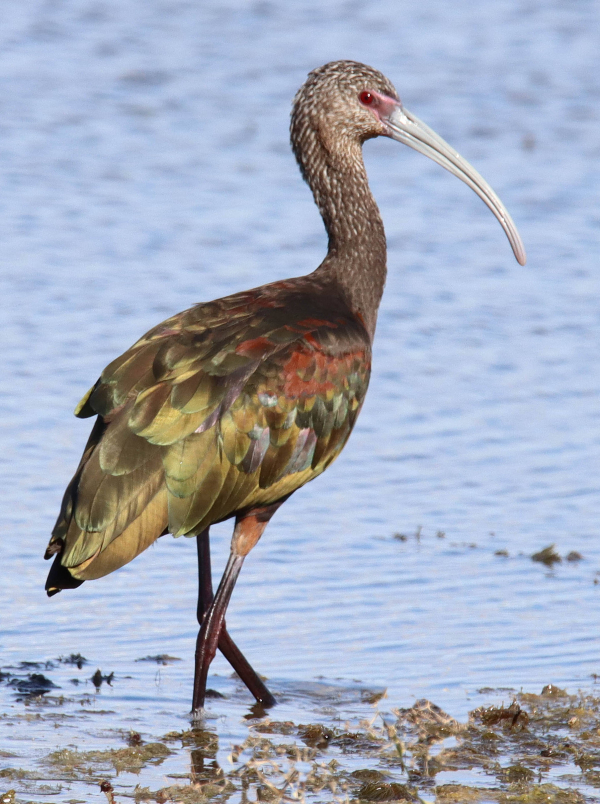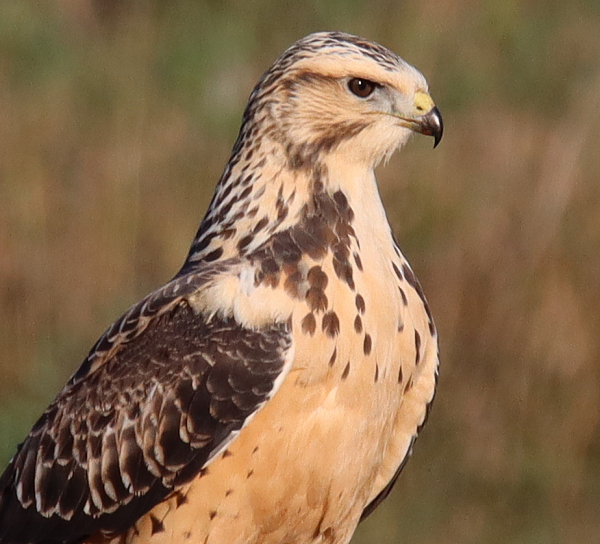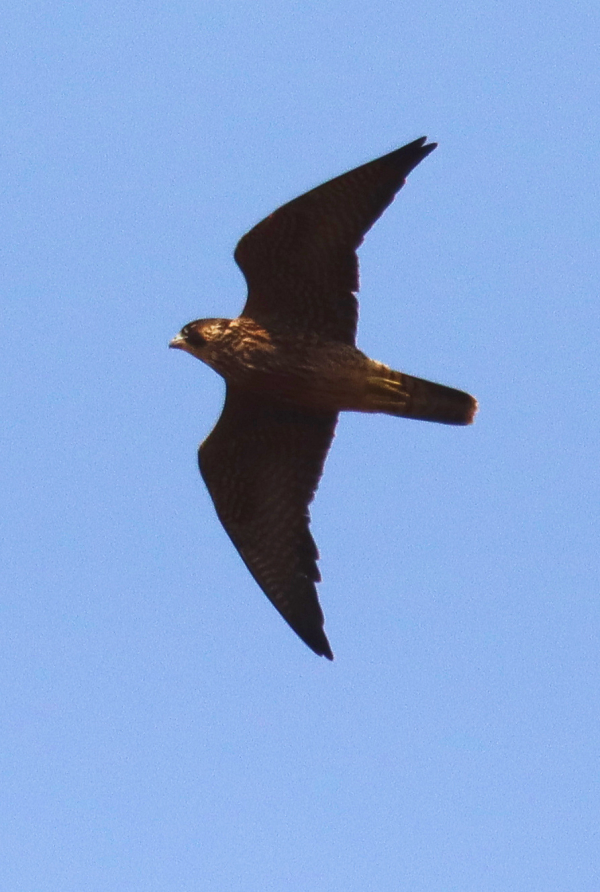
The basic coloration of the head and neck of this White-faced Ibis is offset by the metallic iridescent colors of its body and wing plumage.

Showing the rufous coloration of a recently fledged Northern Harrier, this young raptor provided a spirited flight with quick turns and dives.

Produced by the rufous morph Swainson’s Hawk featured in last week’s Bird Photography feature, this amber-colored fledgling can be counted as a most impressive-looking Swainson’s fledgling.

This foraging Wilson’s Phalarope can be considered a representative of the many migrating shorebirds now in basic plumage.

The excitement of seeing a Peregrine Falcon slicing into a strong south wind was worthy of a quick documentary photo at the beginning of what turned out to be a 3 falcon afternoon.
|
Three falcons in a day is hard to beat, but when you start with a sighting of a Peregrine Falcon in spirited diving flight into a strong south wind, it becomes a more likely possibility. After sighting an American Kestrel, I still didn’t expect to find a third falcon species, even though a Prairie Falcon or Merlin were possible along the Missouri Slope as I drove to Bismarck. I struck out during the drive, but in Bismarck proper, when I least expected it, there was a young Merlin. The Merlin was darker colored than a Prairie Merlin, meaning it probably originated a bit farther north in the forests of Canada rather than the prairie-parkland. The Peregrine was also a first-fall migrant, probably originating even farther north in the Arctic, as indicated by its dark immature plumage.
Along with many expected species observed along the way last Wednesday, east of the capitol city interesting shorebird sightings dominated the McKenzie and Dogtown wetlands. In the shallows of the south side of McKenzie Slough, Long-billed Dowitchers dominated the sandpipers assembled with a couple large flocks combining to number more than 200, and there were still about 80 American Avocets and many Least and Pectoral Sandpipers, along with a few Stilt Sandpipers too. On the edges of Dogtown WPA I found a few Wilson’s Phalaropes, Common Snipe, and a couple Least Sandpipers. All the shorebirds were now in basic plumage, and the swimming phalaropes provided a few photo opportunities as they foraged.
Migration Forecast “High”
The wind changed midday Thursday from a strong south wind to a west wind that turned into a strong north wind, followed by sprinkles late in the day and a soaking rain overnight – usually good signs for migration stopover action – and the BirdCast migration forecast for the night was “High.” But the big overhead migration overnight didn’t bring new birds to my neighborhood, but my last Baltimore Oriole of the year joined the flight south. At least 2 Ruby-throated Hummingbirds remained, and 1 or 2 continued through the week.
Half-mile away a flock of more than 20 Cedar Waxwings hawking flying insects from high perches at the top of a tall cottonwood tree Friday, along with at least 30 Tree Swallows on wing above and beyond the big cottonwood. But the only other migrant in my neighborhood was a surprise sunset stopover Monday by a Swainson’s Thrush that perched in a sumac outside my left bay window before joining American Robins in a chokecherry tangle.
Raptor Saturday
Beautiful sunshine with a fair west wind Saturday made me want to repeat the northwest raptor circle route I initiated 5 days before, hoping to see more falcons among the expected hawks – perhaps a Prairie Falcon among them this time. Instead, the dramatic flights of a couple post-fledging Northern Harriers stole the show. Of the 5 harriers I found, 3 probably fledged about a month ago, each operating independently a few miles apart and suggesting they were migrants – the first harrier fledglings I’ve seen in the area this year.
In spite of their recent introduction to flying, the young harriers were not reserved, showing some real flight prowess as they made sharp turns and dives. The first one I observed was enthralled in some tight dives downward than up, perhaps attracting more attention than it expected considering it was approached in a rather aggressive manner by an adult Swainson’s Hawk. But with both birds in close flights, rather than fleeing the young Northern Harrier addressed the adult hawk with fleet aerial moves that eventually included circling with the slower Swainson’s.
During the drive I counted 29 raptors including 15 Red-tailed Hawks with a Krider’s Red-tail among them, plus 9 Swainson’s Hawks, and 5 Northern Harriers. Other standout birds along the way included a White-faced Ibis that provided some nice portrait photos, a surprise drake Bufflehead (an early arrival), an American Bittern in flight, and just 150 yards from home a recently fledged Red-headed Woodpecker, which I believe was a migrant on its own, considering I haven’t seen or heard a Red-head closer than 17 miles away during the nesting season.
After completing my raptor drive about 6:30, the sunlight was so nice that I thought I’d see if I could muster a photo opportunity south of my office. As I approached the Swainson’s Hawk territory where the rufous morph female and her mate were attending their 3 fledglings I saw a hawk fly low from a good photo vantage point, which suggested I was moments too late. But wait, there was a fledgling perched on a hay bale fairly close to the road – not just any fledgling, but one of the most beautiful Swainson’s fledglings I’ve ever seen.
This bird was facing in my direction, showing its light amber-colored underside and face, distinguished with some dark brown spotting on each side of its neck. I took a few photos of it before it turned to the side, showing its lighter than normal dorsal side, with buffy borders outlining the medium brown covert wing feathers that extended to its back – a really impressive and beautiful raptor! I took photos as it turned its head, and after some time, it took flight, flying away into the wind, then turning to glide in my direction, continuing along the hillside to my right – toward the low sun that radiated the young raptor’s colors perfectly.
Sunday Sunshine
The prize of the day was a close observation of a large female Prairie Falcon along the Lost Road, south of my office. Like Saturday but without the wind, Sunday provided prime birding that included a few late migrants – a pair of Western Kingbirds, a Say’s Phoebe, and a Common Nighthawk. There were a few big flocks of Mourning Doves and Tree Swallows, with smaller groups of Barn Swallows and Killdeer, while Meadow Larks were obvious, as were scattered Northern Flickers, including 7 total. Obviously missing during the past week are Orchard Orioles. Aside from the exciting falcon, other raptors included 3 American Kestrels, 9 Red-tails, 8 Swainson’s Hawks including a “new” adult pair and 3 fledglings.
Whether you are excited by songbirds, waterfowl, shorebirds, raptors, wading birds, or others, mid-September is a great time of the year to be an active birder – as active as your schedule permits. Birders never seem to have “nothing to do,” especially during active migration periods, so enjoy the time you can devote to using your binoculars, spotting scope, and camera; and be aware wherever you go of each bird you see – you never know what interesting bird will present itself for you to appreciate. Enjoy the season!
Article and photos by Paul Konrad
Share your bird sightings and photographs at editorstbw2@gmail.com